The Effects of Sterilization Procedures on the Cutting Efficiency of Endodontic Instruments: A Systematic Review and Network Meta-Analysis
Abstract
1. Introduction
2. Materials and Methods
2.1. Eligibility Criteria
2.2. Research Methodology
2.3. Screening Methodology
2.4. Statistical Analysis Protocol
3. Results
3.1. Study Characteristics and Data Extraction
3.2. Risk of Bias
- Sample size calculation: Is the sample size adequate for obtaining statistically significant results?
- Meaningful difference between groups: Has the “meaningful difference” measurement been set correctly in the groups taking into account the sample size and the type of measurement?
- Sample preparation and handling: Does the study describe information on the production or handling of the samples to be tested?
- Allocation sequence, randomization, and blinding: Did the samples have equal and independent possibility of a sample entering any group?
- Statistical analysis: Are the statistical methods described?
3.3. Meta-Analysis Results
4. Discussion
4.1. Sterilization Methods
- Corrosive effects both from disinfectant agents (sodium hypochlorite) with the phenomenon of micropitting, and from oxygen, with the formation of NiTi oxides under thermal stress in an autoclave [43].
- An increase in surface roughness of the surface in nickel titanium following autoclave sterilization [44].
- Partial recovery of macroscopic deformities in NiTi instruments after sterilization treatment in the autoclave [45].
- Partial recovery of cyclic fatigue suffered by NiTi instruments (most but not all studies) in the autoclave [46].
- Partial recovery of the torsional stress of the NiTi instruments, but not the totality of the studies, in the autoclave [47].
- Reduction in the cutting angle and of the resistance of endodontic instruments in steel subjected to the autoclave and partially for NiTi [21].
4.2. Effect of Sterilization on Cutting Efficiency
4.3. Materials
4.3.1. NiTi
4.3.2. Stainless Steel
4.4. Investigation Methods
4.5. Meta-Analysis
5. Conclusions
Author Contributions
Funding
Institutional Review Board Statement
Informed Consent Statement
Data Availability Statement
Conflicts of Interest
References
- Laneve, E.; Raddato, B.; Dioguardi, M.; di Gioia, G.; Troiano, G.; Muzio, L.L. Sterilisation in Dentistry: A Review of the Literature. Int. J. Dent. 2019, 2019, 1–9. [Google Scholar] [CrossRef] [PubMed]
- Bagg, J.; Smith, A.J.; Hurrell, D.; McHugh, S.; Irvine, G.H. Pre-sterilisation cleaning of re-usable instruments in general dental practice. Br. Dent. J. 2007, 202, E22. [Google Scholar] [CrossRef][Green Version]
- Kumar, K.V.; Kumar, K.K.; Supreetha, S.; Raghu, K.N.; Veerabhadrappa, A.C.; Deepthi, S. Pathological evaluation for sterilization of routinely used prosthodontic and endodontic instruments. J. Int. Soc. Prev. Community Dent. 2015, 5, 232–236. [Google Scholar] [CrossRef] [PubMed]
- Dioguardi, M.; Sovereto, D.; Illuzzi, G.; Laneve, E.; Raddato, B.; Arena, C.; Caponio, V.C.A.; Caloro, G.A.; Zhurakivska, K.; Troiano, G.; et al. Management of Instrument Sterilization Workflow in Endodontics: A Systematic Review and Meta-Analysis. Int. J. Dent. 2020, 2020, 1–20. [Google Scholar] [CrossRef]
- McGuigan, M.B.; Louca, C.; Duncan, H.F. Endodontic instrument fracture: Causes and prevention. Br. Dent. J. 2013, 214, 341–348. [Google Scholar] [CrossRef] [PubMed]
- Madarati, A.A.; Watts, D.C.; Qualtrough, A.J.E. Factors contributing to the separation of endodontic files. Br. Dent. J. 2008, 204, 241–245. [Google Scholar] [CrossRef] [PubMed]
- Zhao, D.; Shen, Y.; Peng, B.; Haapasalo, M. Effect of autoclave sterilization on the cyclic fatigue resistance of thermally treated Nickel-Titanium instruments. Int. Endod. J. 2016, 49, 990–995. [Google Scholar] [CrossRef] [PubMed]
- Viana, A.C.D.; Gonzalez, B.M.; Buono, V.T.L.; Bahia, M.G.A. Influence of sterilization on mechanical properties and fatigue resistance of nickel–titanium rotary endodontic instruments. Int. Endod. J. 2006, 39, 709–715. [Google Scholar] [CrossRef] [PubMed]
- Khabiri, M.; Ebrahimi, M.; Saei, M.R. The Effect of Autoclave Sterilization on Resistance to Cyclic Fatigue of Hero Endodontic File #642 (6%) at Two Artificial Curvature. J. Dent. 2017, 18, 277–281. [Google Scholar]
- Silvaggio, J.; Hicks, M.L. Effect of heat sterilization on the torsional properties of rotary nickel-titanium endodontic files. J. Endod. 1997, 23, 731–734. [Google Scholar] [CrossRef]
- Casper, R.B.; Roberts, H.W.; Roberts, M.D.; Himel, V.T.; Bergeron, B.E. Comparison of Autoclaving Effects on Torsional Deformation and Fracture Resistance of Three Innovative Endodontic File Systems. J. Endod. 2011, 37, 1572–1575. [Google Scholar] [CrossRef] [PubMed]
- King, J.B.; Roberts, H.W.; Bergeron, B.E.; Mayerchak, M.J. The effect of autoclaving on torsional moment of two nickel-titanium endodontic files. Int. Endod. J. 2011, 45, 156–161. [Google Scholar] [CrossRef] [PubMed]
- Qaed, N.-A.; Mourshed, B.-D.; Al-Shamiri, H.-M.; Alaizari, N.; Alhamdah, S.-S. The Effect of surface topographical changes of two different surface treatments rotary instrument. J. Clin. Exp. Dent. 2017, 10, e49–e53. [Google Scholar] [CrossRef] [PubMed]
- Dioguardi, M.; Sovereto, D.; Aiuto, R.; Laino, L.; Illuzzi, G.; Laneve, E.; Raddato, B.; Caponio, V.C.A.; Dioguardi, A.; Zhurakivska, K.; et al. Effects of Hot Sterilization on Torsional Properties of Endodontic Instruments: Systematic Review with Meta-Analysis. Materials 2019, 12, 2190. [Google Scholar] [CrossRef] [PubMed]
- Dioguardi, M.; Crincoli, V.; Laino, L.; Alovisi, M.; Laneve, E.; Sovereto, D.; Raddato, B.; Zhurakivska, K.; Mastrangelo, F.; Ciavarella, D.; et al. Surface Alterations Induced on Endodontic Instruments by Sterilization Processes, Analyzed with Atomic Force Microscopy: A Systematic Review. Appl. Sci. 2019, 9, 4948. [Google Scholar] [CrossRef]
- Liberati, A.; Altman, D.G.; Tetzlaff, J.; Mulrow, C.; Gotzsche, P.C.; Ioannidis, J.P.; Clarke, M.; Devereaux, P.J.; Kleijnen, J.; Moher, D. The PRISMA statement for reporting systematic reviews and meta-analyses of studies that evaluate health care interventions: Explanation and elaboration. PLoS Med. 2009, 6, e1000100. [Google Scholar] [CrossRef]
- Moher, D.; Liberati, A.; Tetzlaff, J.; Altman, D.G.; Group, P. Preferred reporting items for systematic reviews and meta-analyses: The PRISMA statement. PLoS Med. 2009, 6, e1000097. [Google Scholar] [CrossRef] [PubMed]
- Bourvis, N.; Boelle, P.-Y.; Cesbron, J.-Y.; Valleron, A.-J. Risk Assessment of Transmission of Sporadic Creutzfeldt-Jakob Disease in Endodontic Practice in Absence of Adequate Prion Inactivation. PLoS ONE 2007, 2, e1330. [Google Scholar] [CrossRef] [PubMed]
- Yang, Y.J.; Hou, B.X.; Hou, X.M. Metallurgic behavior and mechanical property of nickel-titanium endodontic files made by 3 heat treatment techniques. Zhonghua Kouqiang Yixue Zazhi = Chin. J. Stomatol. 2018, 53, 539–545. [Google Scholar]
- Zupanc, J.; Vahdat-Pajouh, N.; Schäfer, E. New thermomechanically treated NiTi alloys—A review. Int. Endod. J. 2018, 51, 1088–1103. [Google Scholar] [CrossRef]
- Schafer, E. Effect of sterilization on the cutting efficiency of PVD-coated nickel-titanium endodontic instruments. Int. Endod. J. 2002, 35, 867–872. [Google Scholar] [CrossRef]
- Haïkel, Y.; Serfaty, R.; Bleicher, P.; Lwin, T.-T.C.; Allemann, C. Effects of cleaning, disinfection, and sterilization procedures on the cutting efficiency of endodontic files. J. Endod. 1996, 22, 657–661. [Google Scholar] [CrossRef]
- Rapisardaa, E.; Bonaccorsob, A.; Tripib, T.R.; Condorellic, G.G. Effect of sterilization on the cutting efficiency of rotary nickel-titanium endodontic files. Oral Surg. Oral Med. Oral Pathol. Oral Radiol. Endodontol. 1999, 88, 343–347. [Google Scholar] [CrossRef]
- Seago, S.T.; Bergeron, B.E.; Kirkpatrick, T.C.; Roberts, M.D.; Roberts, H.W.; Himel, V.T.; Sabey, K.A. Effect of Repeated Simulated Clinical Use and Sterilization on the Cutting Efficiency and Flexibility of Hyflex CM Nickel-Titanium Rotary Files. J. Endod. 2015, 41, 725–728. [Google Scholar] [CrossRef]
- Haïkel, Y.; Serfaty, R.; Wilson, P.; Speisser, J.; Allemann, C. Cutting efficiency of nickel-titanium endodontic instruments and the effect of sodium hypochlorite treatment. J. Endod. 1998, 24, 736–739. [Google Scholar] [CrossRef]
- Neal, R.G.; Craig, R.G.; Powers, J.M. Effect of sterilization and irrigants on the cutting ability of stainless steel files. J. Endod. 1983, 9, 93–96. [Google Scholar] [CrossRef]
- Morrison, S.W.; Newton, C.W.; Brown, C.E. The effects of steam sterilization and usage on cutting efficiency of endodontic instruments. J. Endod. 1989, 15, 427–431. [Google Scholar] [CrossRef]
- Krithikadatta, J.; Datta, M.; Gopikrishna, V. CRIS Guidelines (Checklist for Reporting In-vitro Studies): A concept note on the need for standardized guidelines for improving quality and transparency in reporting in-vitro studies in experimental dental research. J. Conserv. Dent. 2014, 17, 301–304. [Google Scholar] [CrossRef]
- Morrison, A.; Conrod, S. Dental burs and endodontic files: Are routine sterilization procedures effective? J. Can. Dent. Assoc. 2009, 75, 39. [Google Scholar] [PubMed]
- Zmener, O.; Speilberg, C. Cleaning of endodontic instruments before use. Dent. Traumatol. 1995, 11, 10–14. [Google Scholar] [CrossRef] [PubMed]
- Filho, M.T.; Leonardo, M.R.; Bonifácio, K.C.; Dametto, F.R.; Silva, L.A.B. The use of ultrasound for cleaning the surface of stainless steel and nickel-titanium endodontic instruments. Int. Endod. J. 2001, 34, 581–585. [Google Scholar] [CrossRef] [PubMed]
- Hauptman, J.M.; Golberg, M.B.; Rewkowski, C.A.; Dds, J.M.H.B.; Dmd, C.A.R. The Sterility of Dental Burs Directly from the Manufacturer. J. Esthet. Restor. Dent. 2006, 18, 268–272. [Google Scholar] [CrossRef]
- Subha, N.; Prabhakar, V.; Koshy, M.; Abinaya, K.; Prabu, M.; Thangavelu, L. Efficacy of Peracetic Acid in Rapid Disinfection of Resilon and Gutta-percha Cones Compared with Sodium Hypochlorite, Chlorhexidine, and Povidone-iodine. J. Endod. 2013, 39, 1261–1264. [Google Scholar] [CrossRef]
- Walker, J.T.; Dickinson, J.; Sutton, J.M.; Raven, N.D.H.; Marsh, P.D. Cleanability of dental instruments—Implications of residual protein and risks from Creutzfeldt-Jakob disease. Br. Dent. J. 2007, 203, 395–401. [Google Scholar] [CrossRef] [PubMed]
- Keir, D.M.; Senia, E.S.; Montgomery, S. Effectiveness of a brush in removing postinstrumentation canal debris. J. Endod. 1990, 16, 323–327. [Google Scholar] [CrossRef]
- Sasaki, J.-I.; Imazato, S. Autoclave sterilization of dental handpieces: A literature review. J. Prosthodont. Res. 2020, 64, 239–242. [Google Scholar] [CrossRef]
- Svec, T.A.; Powers, J.M. Effects of simulated clinical conditions on nickel-titanium rotary files. J. Endod. 1999, 25, 759–760. [Google Scholar] [CrossRef]
- Kolstad, R.A. How Well Does the Chemiclave Sterilize Handpieces? J. Am. Dent. Assoc. 1998, 129, 985–991. [Google Scholar] [CrossRef]
- Sastri, V.R. Chapter 4—Material Requirements for Plastics used in Medical Devices. In Plastics in Medical Devices; Sastri, V.R., Ed.; William Andrew Publishing: Boston, MA, USA, 2010; pp. 33–54. [Google Scholar] [CrossRef]
- Venkatasubramanian, R.; Das, U.M.; Bhatnagar, S. Comparison of the effectiveness of sterilizing endodontic files by 4 different methods: Anin vitrostudy. J. Indian Soc. Pedod. Prev. Dent. 2010, 28, 2–5. [Google Scholar] [CrossRef] [PubMed]
- Véliz, E.; Vergara, T.; Pearcy, M.; Dabanch, J. Importancia del proceso de limpieza y desinfección de superficies críticas en un servicio dental. Impacto de un programa de intervención. Rev. Chil. Infectología 2018, 35, 88–90. [Google Scholar] [CrossRef]
- Yılmaz, K.; Uslu, G.; Özyürek, T.; Yilmaz, K. Effect of multiple autoclave cycles on the surface roughness of HyFlex CM and HyFlex EDM files: An atomic force microscopy study. Clin. Oral Investig. 2018, 22, 2975–2980. [Google Scholar] [CrossRef] [PubMed]
- Berutti, E.; Angelini, E.; Rigolone, M.; Migliaretti, G.; Pasqualini, D. Influence of sodium hypochlorite on fracture properties and corrosion of ProTaper Rotary instruments. Int. Endod. J. 2006, 39, 693–699. [Google Scholar] [CrossRef] [PubMed]
- Lopes, H.P.; Elias, C.N.; Vieira, M.V.; Vieira, V.T.; de Souza, L.C.; dos Santos, A.L. Influence of Surface Roughness on the Fatigue Life of Nickel-Titanium Rotary Endodontic Instruments. J. Endod. 2016, 42, 965–968. [Google Scholar] [CrossRef]
- Wu, C.-D.; Sung, P.-H.; Fang, T.-H. Study of deformation and shape recovery of NiTi nanowires under torsion. J. Mol. Model. 2013, 19, 1883–1890. [Google Scholar] [CrossRef] [PubMed]
- Arias, A.; Perez-Higueras, J.J.; de la Macorra, J.C. Influence of clinical usage of GT and GTX files on cyclic fatigue resistance. Int. Endod. J. 2013, 47, 257–263. [Google Scholar] [CrossRef] [PubMed]
- Canalda-Sahli, C.; Brau-Aguade, E.; Sentis-Vilalta, J. The effect of sterilization on bending and torsional properties of K-files manufactured with different metallic alloys. Int. Endod. J. 1998, 31, 48–52. [Google Scholar] [CrossRef] [PubMed]
- Troiano, G.; Dioguardi, M.; Cocco, A.; Giuliani, M.; Fabiani, C.; d’Alessandro, A.; Ciavarella, D.; Muzio, L.L. Centering Ability of ProTaper Next and WaveOne Classic in J-Shape Simulated Root Canals. Sci. World J. 2016, 2016, 1–5. [Google Scholar] [CrossRef] [PubMed]
- Fayyad, D.M.; Elgendy, A.A.E. Cutting Efficiency of Twisted versus Machined Nickel-Titanium Endodontic Files. J. Endod. 2011, 37, 1143–1146. [Google Scholar] [CrossRef]
- Cooley, R.L.; Marshall, T.D.; Young, J.M.; Huddleston, A.M. Effect of sterilization on the strength and cutting efficiency of twist drills. Quintessence Int. 1990, 21, 919–923. [Google Scholar] [PubMed]
- Mitchell, B.F.; James, G.A.; Nelson, R.C. The effect of autoclave sterilization on endodontic files. Oral Surg. Oral Med. Oral Pathol. 1983, 55, 204–207. [Google Scholar] [CrossRef]
- Haïkel, Y.; Serfaty, R.; Bleicher, P.; Lwin, T.-T.C.; Allemann, C. Effects of cleaning, chemical disinfection, and sterilization procedures on the mechanical properties of endodontic instruments. J. Endod. 1997, 23, 15–18. [Google Scholar] [CrossRef]
- Hilt, B.R.; Cunningham, C.J.; Shen, C.; Richards, N. Torsional Properties of Stainless-Steel and Nickel-Titanium Files After Multiple Autoclave Sterilizations. J. Endod. 2000, 26, 76–80. [Google Scholar] [CrossRef] [PubMed]
- Haïkel, Y.; Serfaty, R.; Lwin, T.-T.C.; Allemann, C. Measurement of the cutting efficiency of endodontic instruments: A new concept. J. Endod. 1996, 22, 651–656. [Google Scholar] [CrossRef]
- Webber, J.; Moser, J.; Heuer, M. A method to determine the cutting efficiency of root canal instruments in linear motion. J. Endod. 1980, 6, 829–834. [Google Scholar] [CrossRef]
- Villalobos, R.; Moser, J.; Heuer, M. A method to determine the cutting efficiency of root canal instruments in rotary motion. J. Endod. 1980, 6, 667–671. [Google Scholar] [CrossRef]
- Molven, O. A comparison of the dentin-removing ability of five root canal instruments. Eur. J. Oral Sci. 1970, 78, 500–511. [Google Scholar] [CrossRef]
- Oliet, S.; Sorin, S.M. Cutting efficiency of endodontic reamers. Oral Surg. Oral Med. Oral Pathol. 1973, 36, 243–252. [Google Scholar] [CrossRef]
- Fromme, H.G.; Riedel, H. Treatment of Dental Root Canals and the Marginal Contact between Filling Material and Tooth, studied by Scanning Electronic Microscopy. Int. Endod. J. 1972, 6, 17–20. [Google Scholar] [CrossRef] [PubMed]
- Stefanescu, T.; Popovici, R.A.; Antoniac, I.V.; Galuscan, A.; Tirca, T. Ni-Ti Rotary Instrument Fracture Analysis after Clinical Use. Structure Changes in Used Instruments. Environ. Eng. Manag. J. 2016, 15, 981–988. [Google Scholar] [CrossRef]
- Matei, A.; Pencea, I.; Stanciu, S.; Hristu, R.; Antoniac, I.; Coman, E.C.; Sfat, C.; Stanciu, G. Structural characterization and adhesion appraisal of TiN and TiCN coatings deposited by CAE-PVD technique on a new carbide composite cutting tool. J. Adhes. Sci. Technol. 2015, 29, 2576–2589. [Google Scholar] [CrossRef]
- Inan, U.; Keskin, C. Torsional Resistance of ProGlider, Hyflex EDM, and One G Glide Path Instruments. J. Endod. 2019, 45, 1253–1257. [Google Scholar] [CrossRef] [PubMed]
- Spagnuolo, G.; Ametrano, G.; d’Antò, V.; Rengo, C.; Simeone, M.; Riccitiello, F.; Amato, M. Effect of autoclaving on the surfaces of TiN-coated and conventional nickel-titanium rotary instruments. Int. Endod. J. 2012, 45, 1148–1155. [Google Scholar] [CrossRef] [PubMed]
- Razavian, H.; Iranmanesh, P.; Mojtahedi, H.; Nazeri, R. Effect of Autoclave Cycles on Surface Characteristics of S-File Evaluated by Scanning Electron Microscopy. Iran. Endod. J. 2015, 11, 29–32. [Google Scholar]
- Nair, A.S.; Tilakchand, M.; Naik, B.D. The effect of multiple autoclave cycles on the surface of rotary nickel-titanium endodontic files: An in vitro atomic force microscopy investigation. J. Conserv. Dent. 2015, 18, 218–222. [Google Scholar] [CrossRef] [PubMed]
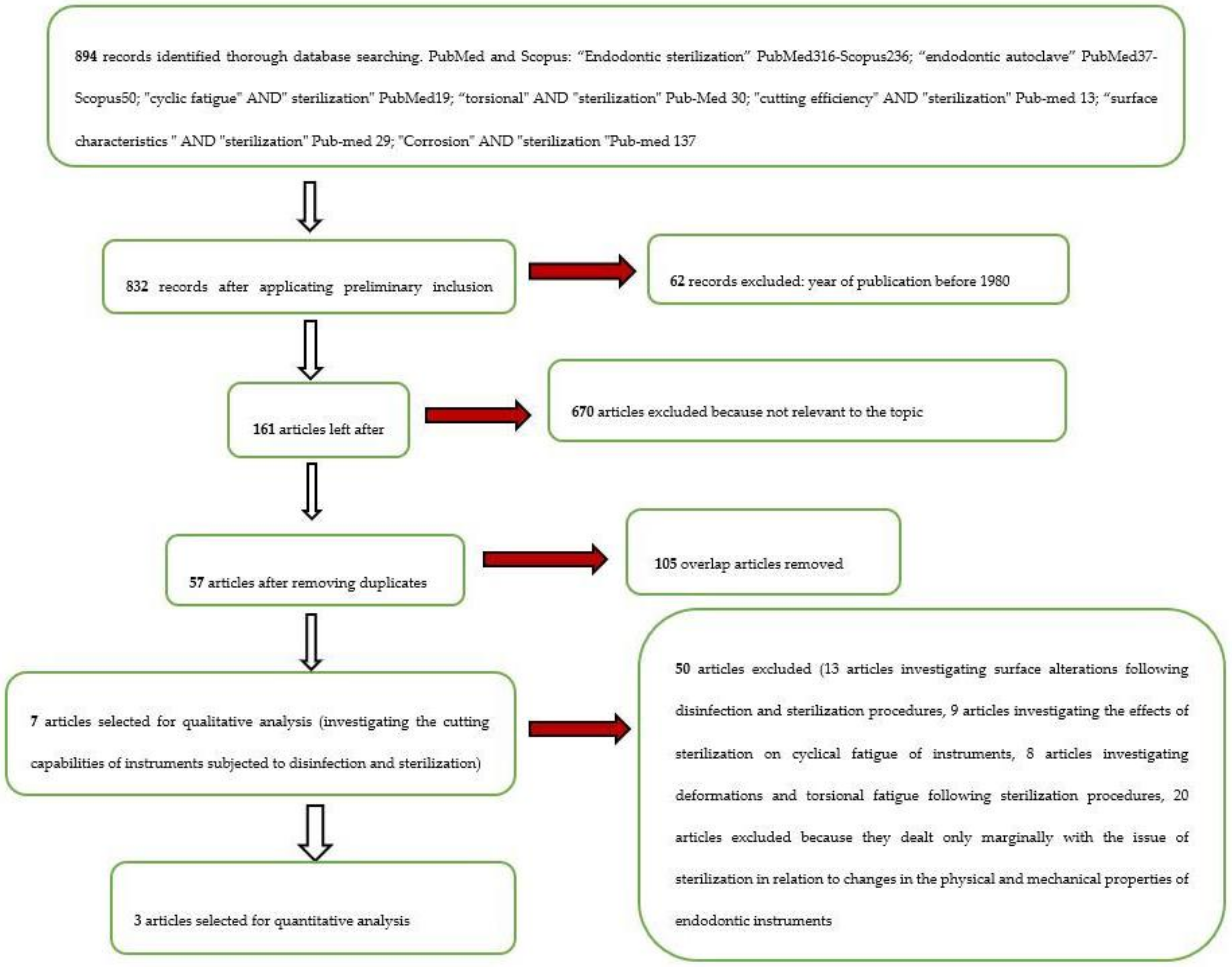
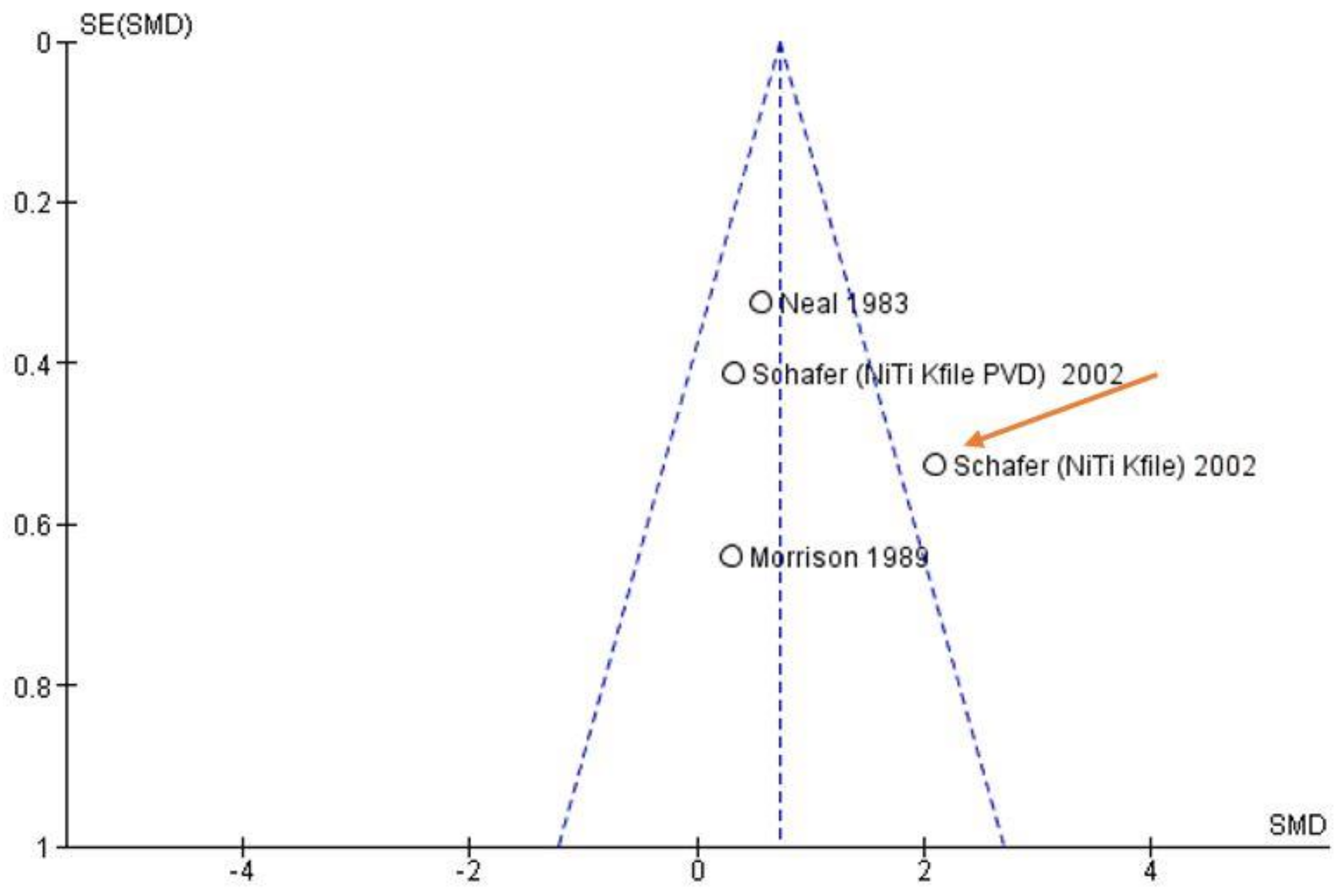

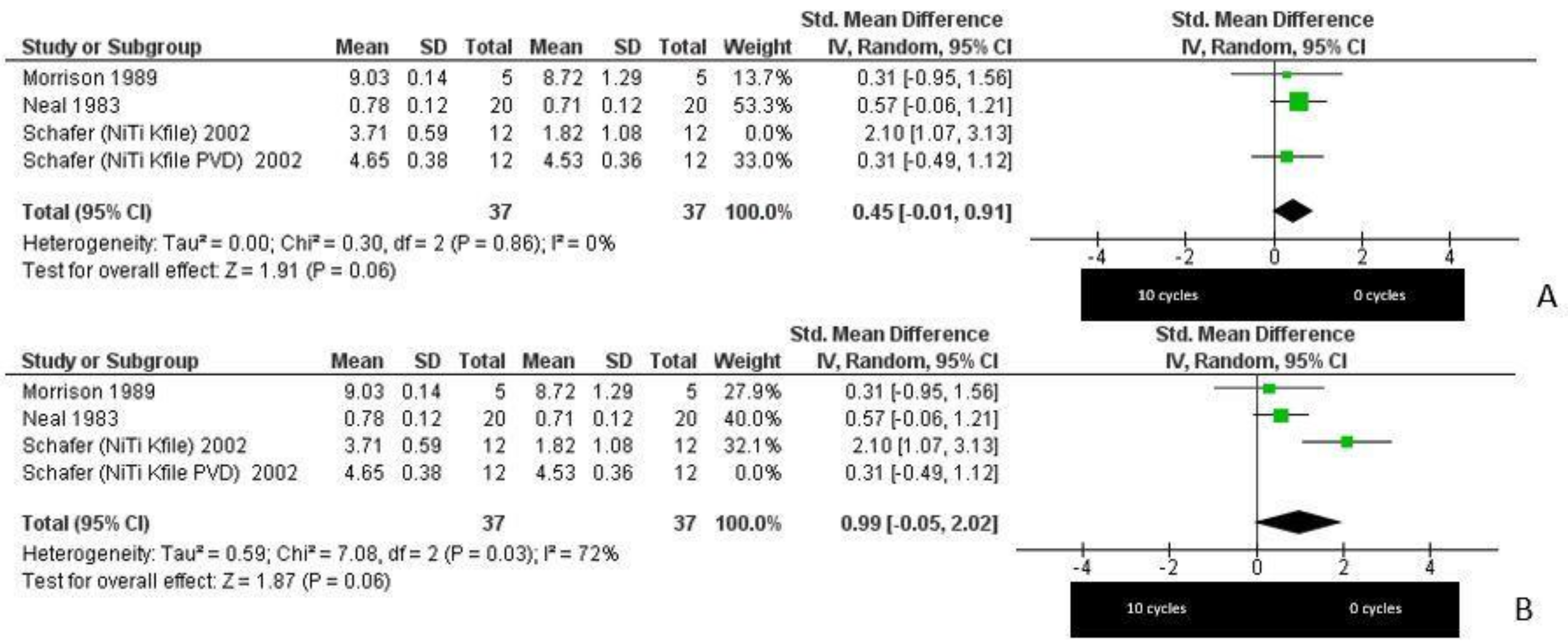
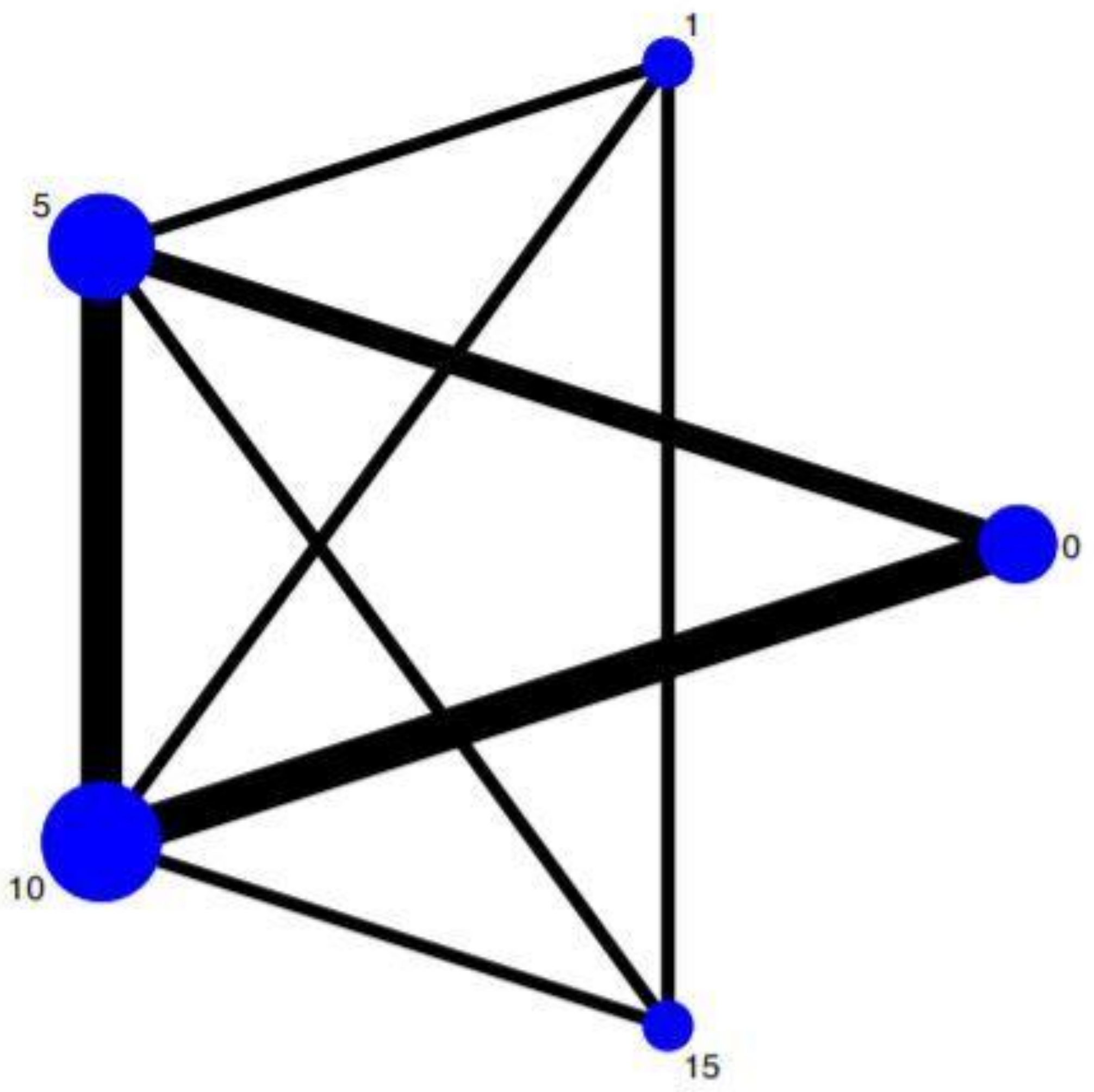
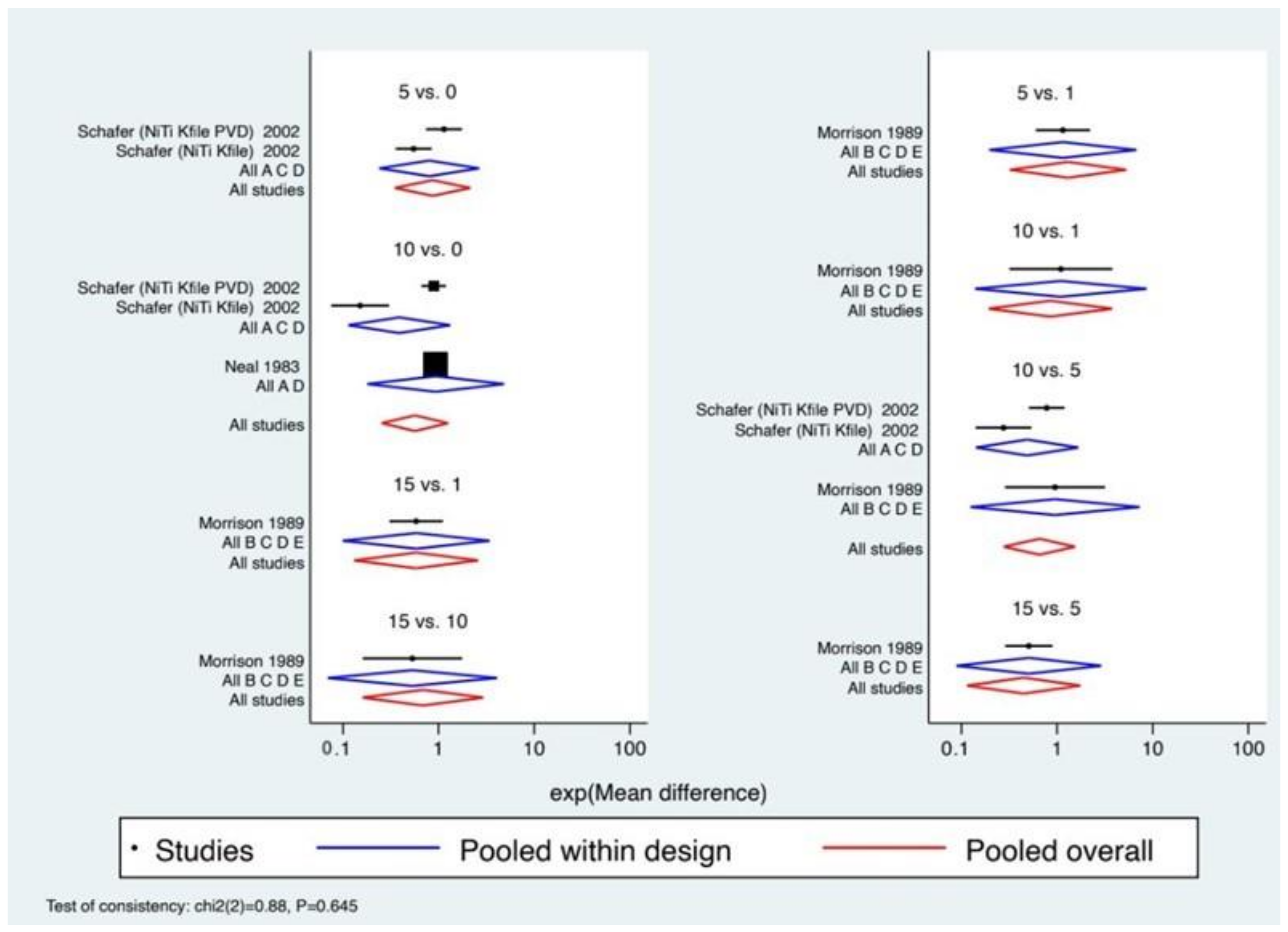
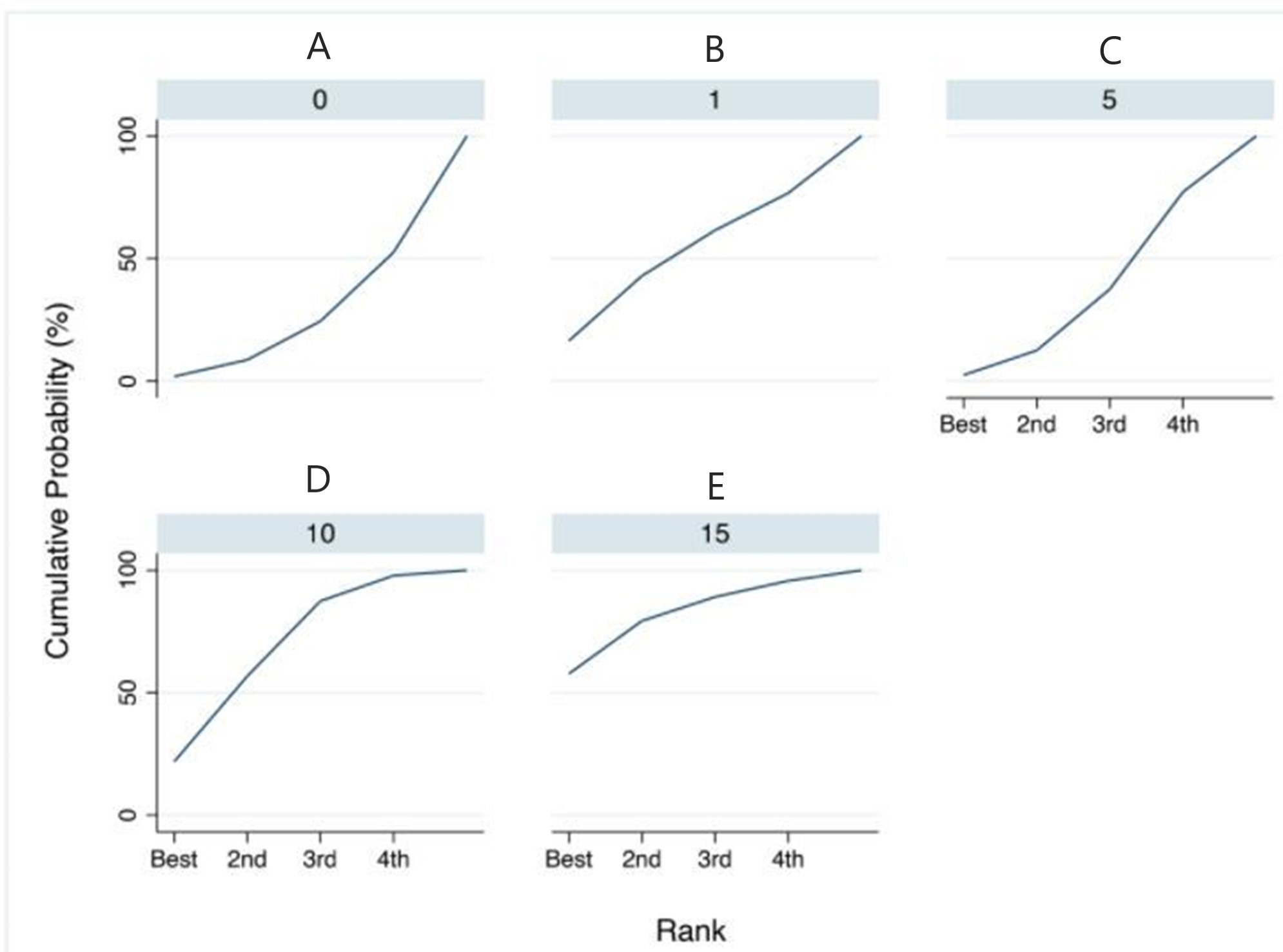
| Database—Provider | Keywords | Number of Records | Number of Records after Restriction by Year of Publication (Last 40 Years) | Number of Remaining Articles after Screening for the Latest Review Topic | Articles after Removing Overlaps | Articles Remaining after Applying the Inclusion and Exclusion Criteria | Articles Included in the Meta-Analysis |
|---|---|---|---|---|---|---|---|
| PubMed | “endodontic sterilization” | 316 | 277 | 35 | \ | \ | \ |
| PubMed | “endodontic autoclave” | 37 | 36 | 21 | \ | \ | \ |
| PubMed | “cyclic fatigue” AND “sterilization” | 19 | 19 | 16 | \ | \ | \ |
| PubMed | “torsional” AND “sterilization” | 30 | 30 | 17 | \ | \ | \ |
| PubMed | “cutting efficiency” AND “sterilization” | 13 | 13 | 6 | \ | \ | \ |
| PubMed | “surface characteristics” AND “sterilization” | 29 | 29 | 3 | \ | \ | \ |
| PubMed | “corrosion” AND “sterilization” | 137 | 115 | 6 | \ | \ | \ |
| SCOPUS | “endodontic” AND “sterilization” | 263 | 263 | 36 | \ | \ | \ |
| Scopus | “endodontic” AND “autoclave” | 50 | 50 | 21 | \ | \ | \ |
| Total records | 894 | 832 | 161 | 57 | 7 | 3 |
| First Author; Reference | Instruments | Autoclave Cycles | Number of Instruments | Depth of Cuts (mm), Mass of Cuts (µg) | Standard Deviation | Reduction of Cutting Efficiency, Expressed as a Percentage of the Control | Type of Autoclave | Time and Temperature | Results |
|---|---|---|---|---|---|---|---|---|---|
| Morrison et al. 1989 [27] | stainless steel #25 Flexofile | 0 | 5 | 9.03 | 0.14 | steam autoclave (Amsco Medalist 200, American Sterilizer Co., Erie, PA, USA) | 15 min, 121 °C | no signilicant difference c in cutting efficiency | |
| 1 | 5 | 8.63 | 0.58 | ||||||
| 5 | 5 | 8.77 | 0.47 | ||||||
| 10 | 5 | 8.72 | 1.29 | ||||||
| 15 | 5 | 8.09 | 0.45 | ||||||
| 1 after use 1 molar | 10 | 8.34 | 0.77 | ||||||
| 5 after use 5 molar | 10 | 7.07 | 0.83 | ||||||
| 10 after use 10 molar | 10 | 6.84 | 0.69 | ||||||
| Schafer et al. 2002 [21] | NiTi Kfile 35# | 0 | 12 | 3.71 | 0.59 | Aesculap Automat 356 (Aesculap, Tuttlingen, Germany). | 30 min, 134 °C | 50.6–16.1% NiTi Kfile (10–5 cycles) | |
| 5 | 12 | 3.11 | 0.49 | 16.1% | |||||
| 10 | 12 | 1.82 | 1.08 | 50.6% | |||||
| 5 + NaOCl treatment | 12 | 3.06 | 0.65 | ||||||
| NiTi Kfile PVD 35# | 0 | 12 | 4.65 | 0.38 | |||||
| 5 | 12 | 4.78 | 0.67 | ||||||
| 10 | 12 | 4.53 | 0.36 | ||||||
| 5 + NaOCl treatment | 12 | 4.30 | 0.44 | ||||||
| Neal et al. 1983 [26] | K-type #30 stainless steel files | 0 | 20 | 0.78 | 0.12 | autoclave bags (Lorvic Corp., St. Louis, MO, USA) | 30 min, 270 °F | autoclave sterilization resulted in a small but significant decrease in cutting ability of the files. | |
| 10 | 20 | 0.71 | 0.12 | ||||||
| Haikel et al. 1996 [22] | stainless steel Unifile #30 | 0 | 10 | 132.4 1 ± 0020 | chemiclave | 30 min, 131 °C | Unifile and Flexofile, a cutting efficiency reduction (range of 20% to 70%) | ||
| 5 | 10 | 38.2 1 ± 0.0005 | 63.90% | ||||||
| 10 | 10 | 35.91 ± 0.0003 | 67.10% | ||||||
| stainless steel H-file #30 | 0 | 10 | 141.6 1 ± 0.0020 | ||||||
| 5 | 10 | 43.1 1 ± 0.0003 | 68.10% | ||||||
| 10 | 10 | 46.8 1 ± 0.0003 | 50.40% | ||||||
| stainless steel Flexofile #30 | 0 | 10 | 146.9 1 ± 0.0030 | ||||||
| 5 | 10 | 34.7 1 ± 0.0008 | 77.00% | ||||||
| 10 | 10 | 39.7 1 ± 0.0008 | 73.00% | ||||||
| Rapisarda et al. 1999 [23] | NiTi ProFile instruments (#15, #30 #40 #45) | 0 | 12 | Euroclave (Euronda Spa) | 30 min, 121 °C | the number of sterilization cycles was a determining factor as to cutting efficiency | |||
| 7 | 12 | 20% reduction in cutting ability | |||||||
| 14 | 12 | 50% reduction in cutting ability | |||||||
| Seago et al. 2015 [24] | NiTi Hyflex CM Rotary Files 35# | 0, 1, 2, 3, 4, 5, 6, 7, 8, 9, 10 cycles | 60 | STATIM 5000 (SciCan, Toronto, ON, Canada) | 6 min, 132 °C | no statistical decrease after 1, 4, 5, and 6 cycles. A statistically significant decrease in cutting efficiency was for 2 3 7 8 and 9 cycles | |||
| Haikel et al. 1998 [25] | NiTi file Maillefer #30 | 2.5% NaOCl, 12–48 h | (109.8% efficacy)–24.36% | ||||||
| NiTi file Brasseler #30 | 2.5% NaOCl, 12–48 h | 16.42–32.87% | |||||||
| NiTi file JS Denta l#30 | 2.5% NaOCl, 12–48 h | 29.97–25.35% | |||||||
| NiTi file McSpadden #30 | 2.5% NaOCl, 12–48 h | 3.25%–no reduction |
| First Author; Reference | Sample Size Calculation | Meaningful Difference between Groups | Sample Preparation and Handling | Allocation Sequence, Randomization, and Blinding | Statistical Analysis | Score |
|---|---|---|---|---|---|---|
| Schafer et al. (2002) [21] | 3 | 4 | 4 | 4 | 5 | 20 |
| Neal et al. 1983 [26] | 4 | 3 | 3 | 3 | 4 | 17 |
| Morrison et al. (1989) [27] | 2 | 4 | 3 | 3 | 4 | 16 |
| Side | Direct | Indirect | Difference | ||||
|---|---|---|---|---|---|---|---|
| Coef | Std. Err | Coef | Std. Err | Coef | Std. Err | p >|z| | |
| A C | −0.2264099 | 0.5766333 | 0.1967006 | 1.256345 | −0.4231105 | 1.381023 | 0.759 |
| A D | −0.6247653 | 0.4634597 | 0.372054 | 2.195575 | −0.9968193 | 2.249488 | 0.658 |
| B C | 0.1400003 | 0.8378915 | 1.136114 | 2.10521 | −0.9961141 | 2.255608 | 0.659 |
| B D | 0.0900002 | 0.9953451 | −0.9091564 | 1.889073 | 0.9991566 | 2.256189 | 0.658 |
| B E | - | - | - | - | - | - | - |
| C D | −0.5406656 | 0.4789061 | 1.003904 | 1.739389 | −1.544569 | 1.808625 | 0.393 |
| C E | −0.6800003 | 0.8217556 | −1.676114 | 2.09884 | 0.9961141 | 2.255609 | 0.659 |
| D E | −0.6300001 | 0.09818004 | 0.3691565 | 1.881972 | −0.9991566 | 2.256189 | 0.658 |
| Treatment | |||||
|---|---|---|---|---|---|
| Sudy and Rank | 0 cycles (control) | 1 cycle | 5 cycles | 10 cycles | 15 cycles |
| Morrison 1989 | |||||
| Best | 1.7 | 16.3 | 2.3 | 21.8 | 57.7 |
| 2nd | 6.8 | 26.6 | 10.0 | 35.0 | 21.6 |
| 3rd | 15.8 | 18.6 | 25.1 | 30.7 | 9.8 |
| 4th | 28.1 | 15.2 | 39.7 | 10.4 | 6.6 |
| Worst | 47.5 | 23.3 | 22.8 | 2.1 | 4.3 |
| Mean Rank | 4.1 | 3.0 | 3.7 | 2.4 | 1.8 |
| SUCRA | 0.2 | 0.5 | 0.3 | 0.7 | 0.8 |
Publisher’s Note: MDPI stays neutral with regard to jurisdictional claims in published maps and institutional affiliations. |
© 2021 by the authors. Licensee MDPI, Basel, Switzerland. This article is an open access article distributed under the terms and conditions of the Creative Commons Attribution (CC BY) license (http://creativecommons.org/licenses/by/4.0/).
Share and Cite
Dioguardi, M.; Laneve, E.; Di Cosola, M.; Cazzolla, A.P.; Sovereto, D.; Aiuto, R.; Laino, L.; Leanza, T.; Alovisi, M.; Troiano, G.; et al. The Effects of Sterilization Procedures on the Cutting Efficiency of Endodontic Instruments: A Systematic Review and Network Meta-Analysis. Materials 2021, 14, 1559. https://doi.org/10.3390/ma14061559
Dioguardi M, Laneve E, Di Cosola M, Cazzolla AP, Sovereto D, Aiuto R, Laino L, Leanza T, Alovisi M, Troiano G, et al. The Effects of Sterilization Procedures on the Cutting Efficiency of Endodontic Instruments: A Systematic Review and Network Meta-Analysis. Materials. 2021; 14(6):1559. https://doi.org/10.3390/ma14061559
Chicago/Turabian StyleDioguardi, Mario, Enrica Laneve, Michele Di Cosola, Angela Pia Cazzolla, Diego Sovereto, Riccardo Aiuto, Luigi Laino, Teresa Leanza, Mario Alovisi, Giuseppe Troiano, and et al. 2021. "The Effects of Sterilization Procedures on the Cutting Efficiency of Endodontic Instruments: A Systematic Review and Network Meta-Analysis" Materials 14, no. 6: 1559. https://doi.org/10.3390/ma14061559
APA StyleDioguardi, M., Laneve, E., Di Cosola, M., Cazzolla, A. P., Sovereto, D., Aiuto, R., Laino, L., Leanza, T., Alovisi, M., Troiano, G., & Lo Muzio, L. (2021). The Effects of Sterilization Procedures on the Cutting Efficiency of Endodontic Instruments: A Systematic Review and Network Meta-Analysis. Materials, 14(6), 1559. https://doi.org/10.3390/ma14061559












